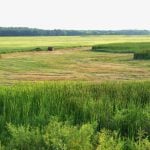All in good taste
The question of whether grazing sheep on spurge affects the taste and quality of the meat is often raised, so a test was set up to compare sheep grazing spurge to animals with no spurge in their diets.
The test consisted of eight mature ewes, four from a bluegrass pasture and four from pastures consisting of bluegrass and spurge. All animals were from the same flock. They were selected for similar body weight and condition.
Tests consisted of three components: chemical composition, shear test and taste panel. Analysis of the chemical composition showed virtually identical levels of protein. Total fat content was lower in animals from the spurge pastures. In particular, there was less marbling, or less fat within the meat, with most of the fat deposited as external fat.
Read Also

VIDEO: Ag in Motion documentary launches second season
The second season of the the Western Producer’s documentary series about Ag in Motion launched Oct. 8.
The shear test, a measure of tenderness, showed similar results for both groups. Fat odor tests which simulate odors during cooking revealed fat from animals with spurge in their diets produced a stronger odor.
The taste panel group comprised eight individuals who evaluated selected cuts for tenderness, juiciness, flavor and overall acceptance. Results for both groups were similar. The meat from the animals with spurge in their diet rated slightly higher for tenderness and flavor and marginally lower for juiciness.
The scores for both groups were identical.
Taste panel results indicated the inclusion of spurge in the animal’s diet does not adversely affect acceptance of the meat as shown by the overall score of the taste panel. Stronger fat odors that may occur during cooking can be reduced by trimming the external fat before cooking.
Due to the small sample size in these tests, the results should only be considered as indicators of trends. The findings will be useful in identifying follow-up research.
– Agriculture Canada/Manitoba Agriculture
Those dirty rats
Two rats can produce 15,000 newborns every year. That’s why farmers are encouraged to rid their farms of the pests immediately, and to eliminate any sites that shelter or feed them, such as spilled grain, or old hay bales or silage pits.
“The biggest concern about rats is the damage they do to food supplies and feed by eating it and defecating in it,” said Cameron Wilk, a program co-ordinator with extension services at Saskatchewan Agriculture. “Other damage is incurred by the rats’ gnawing and tunneling, and disease transmission.
“Rats carry a number of diseases, most memorably the Black Plague, but more recently food poisoning, hepatitis, rat bite fever and leptospirosis, which causes abortions in cattle, are a few of the concerns. The diseases are transmitted on their feet, in their mouth, urine or feces, or by the fleas they carry.”
The kingpin of the rat underworld is the Norway rat, which arrived on boats in Eastern Canada in the 1600s. These not-so-cute rodents slowly moved westward, and showed up in Saskatchewan in the late 1950s, said Wilk.
With a three-week gestation period, 12 to 18 rats are born to a female rat that can be as young as eight weeks of age. The Norway rat may produce up to 12 litters a year.
Control is the key.
The Saskatchewan Rat Control Program, which receives $350,000 from Saskatchewan Agriculture, makes money available to regional boards to hire pest control officers to control rats and persistent perennial weeds such as leafy spurge, said Wilk.
He said rats in municipal landfill sites appear to be the greatest problem now that burning is no longer allowed. Rats will establish themselves there and move on to infest farmyards.
– Saskatchewan Agriculture














